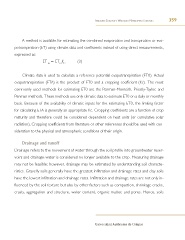Page 359 - FRUTAS DEL TRÓPICO
P. 359
359
iRRigating efficiently: wateRshed management stRategies
A method is available for estimating the combined evaporation and transpiration or eva-
potranspiration (ET) using climate data and coefficients instead of using direct measurements,
expressed as:
ET = ET K (3)
A O C
Climate data is used to calculate a reference potential evapotranspiration (ET0). Actual
evapotranspiration (ETA) is the product of ET0 and a cropping coefficient (Kc). The most
commonly used methods for estimating ET0 are the Penman-Monteith, Priestly-Taylor, and
Penman methods. These methods use only climatic data to estimate ET0 on a daily or monthly
basis. Because of the availability of climatic inputs for the estimating ET0, the limiting factor
for calculating ETA is generally an appropriate Kc. Cropping coefficients are a function of crop
maturity and therefore could be considered dependent on heat units (or cumulative solar
radiation). Cropping coefficients from literature or other references should be used with con-
sideration to the physical and atmospheric conditions of their origin.
Drainage and runoff
Drainage refers to the movement of water through the soil profile into groundwater reser-
voirs and drainage water is considered no longer available to the crop. Measuring drainage
may not be feasible; however, drainage may be estimated by understanding soil characte-
ristics. Gravelly soils generally have the greatest infiltration and drainage rates and clay soils
have the lowest infiltration and drainage rates. Infiltration and drainage rates are not only in-
fluenced by the soil texture but also by other factors such as compaction, shrinkage cracks,
crusts, aggregation and structure, water content, organic matter, and pores. Hence, soils
Universidad Autónoma de Chiapas

